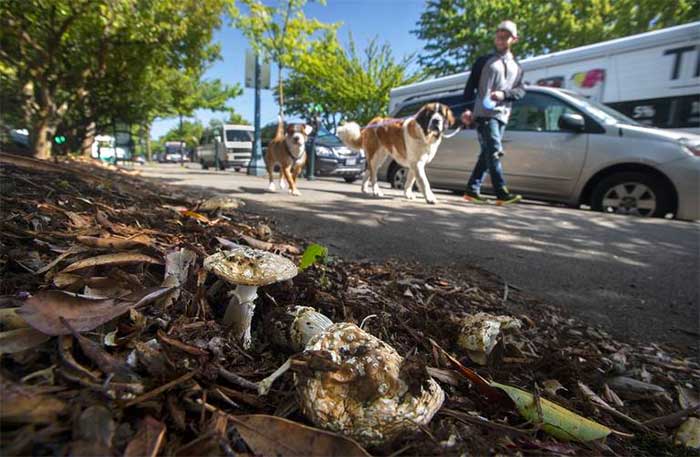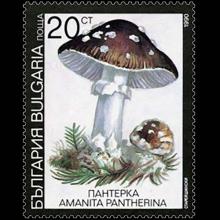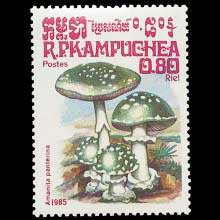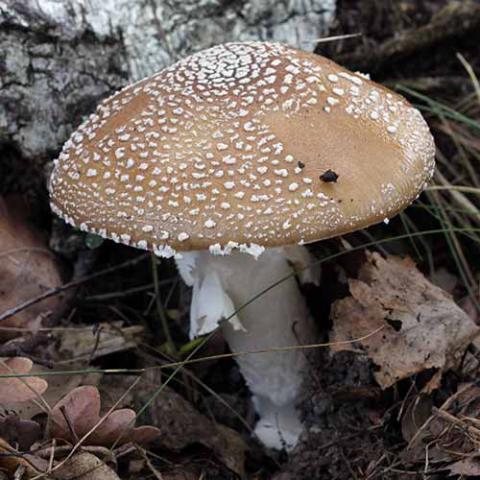NAMES
TAXONOMY
FUNGI ID
THERAPEUTIC
Bulgaria
Issued:
Stamp:
Amanita pantherina
Cambodia
Issued:
Stamp:
Amanita pantherina
Bulgaria
Issued:
Stamp:
Amanita pantherina
Cambodia
Issued:
Stamp:
Amanita pantherina
Bulgaria
Issued:
Stamp:
Amanita pantherina
Cambodia
Issued:
Stamp:
Amanita pantherina
This mushroom season, a reminder to watch what you (and your dogs) eat
by Abby Spegman May 03, 2019
As an amateur mycologist — that’s someone who studies fungi — Ellen King Rice was concerned to see mushrooms she thought were from the Amanita pantherina group sprouting near her home west of Olympia.

These can be attractive to dogs given their fishy smell, but can cause a coma-like sleep if eaten, according to the North American Mycological Association. They also can cause drowsiness, nausea and vomiting in people.
Ah, spring: the sun is out, the birds are chirping — and the mushrooms are here, a good time to remember some types can spell trouble.
“You really need to know what you’re doing,” Marian Maxwell of the Puget Sound Mycological Society said to would-be mushroom hunters.
Spring mushroom season typically starts at the end of April and lasts until June, when it gets too hot and dry. The fall season, which brings more varieties and quantities, runs late September until the first hard frost.
Maxwell said she is not so concerned about Amanita pantherina, which are common in these parts and help trees they grow under to absorb minerals and water.
“They are actually good guys, even though they’re not good for us,” Maxwell said, adding she does not recommend anyone eat them.
This time of year she worries more about morel look-alikes called Gyromitra esculenta, which can be poisonous and even deadly, according to the North American Mycological Association.
The association warns even the coveted morel can cause problems if consumed raw or not thoroughly cooked.
Maxwell said when it comes to people and pets, the best advice is don’t eat a mushroom unless you know what it is. She recommends not relying on pictures but seeking out expert advice or training in the field.
Genus species (Fungi): Amanita pantherina
Amanita pantherina, also known as the panther cap and false blusher due to its similarity to the true blusher (Amanita rubescens), is a species of fungus found in Europe and Western Asia.
Habitat and distribution
The panther cap is an uncommon mushroom, found in both deciduous, especially beech and, less frequently, coniferous woodland and rarely meadows throughout Europe, western Asia in late summer and autumn. It has also been recorded from South Africa, where it is thought to have been accidentally introduced with trees imported from Europe, and on Vancouver Island, in British Columbia, Canada.
It is an ectomycorrhizal fungus, living in root symbiosis with a tree, deriving photosynthesised nutrients from it and providing soil nutrients in return.
Biochemistry and toxicity
Amanita pantherina contains the psychoactive compound muscimol, but is used as an entheogen much less often than its much more distinguishable relative Amanita muscaria. Amanita pantherina var. pantherinoides is considered inedible and possibly poisonous. Varieties multisquamosa and velatipes are considered poisonous.
Reference: Wikipedia, www.britannica.com




